HiRISE
 |
HiRISE is a project mainly funded by the European Research Council (ERC) under the European Union's Horizon 2020 research and innovation programme (grant agreement n°757561). It received additional funding from the Commission Spécialisée Astronomie-Astrophysique (CSAA) and the Action Spécifique Haute Résolution Angulaire (ASHRA) of CNRS/INSU co-funded by CNES, and from Région Provence-Alpes-Côte d'Azur under project ASOREX (grant agreement 2014-0276). |
Context and goals

The atmospheric composition of giant exoplanets provides essential markers of their formation mechanisms (e.g., Öberg et al. 2011), internal structure (e.g., Madhusudhan 2019), bulk properties (e.g., Burrows et al. 1997), or ongoing chemical and dynamical processes (e.g., Moses et al. 2011; Phillips et al. 2020). Some of these markers can be detected and quantified at relatively low spectral resolution (R = λ / Δλ ≤ 100), which is readily accessible in current high-contrast instruments equipped with integral-field spectrographs (IFS). However, spectral resolutions higher than a few thousand are necessary for more detailed measurements: detection of isotopologues (Mollière & Snellen 2019), determination of abundances (Konopacky et al. 2013), measurement of radial velocities to study orbital elements (Ruffio et al. 2019), looking for exo-moons (Vanderburg et al. 2018; Lazzoni et al. 2022; Ruffio et al. 2023), or determination of rotational velocities (Bryan et al. 2018).
 |
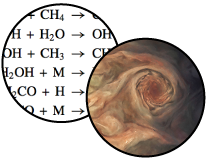 |
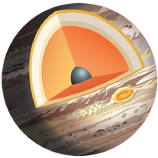 |
| Formation & migration | Atmospheric chemistry & dynamics | Mass & internal structure |
High-dispersion spectroscopy (HDS) for the detection of exoplanetary signal was suggested more than two decades ago as a way to boost the detection capabilities by relying on the numerous spectral features expected in the spectra of exoplanets (Sparks & Ford et al. 2002, Riaud & Schneider et al. 2007). This method was first applied to detect the thermal irradiation of transiting and non-transiting close-in EGPs (Snellen et al. 2010; Brogi et al. 2012; Birkby et al. 2013), before being used to characterize the direct near-infrared (NIR) emission of young EGPs detected with high-contrast imaging (Snellen et al. 2014; Schwarz et al. 2016). This method was then generalized and applied to integral-field-unit data to boost the detection capabilities of existing (e.g., Hoeijmakers et al. 2018) and forthcoming (e.g., Houllé et al. 2021) instruments.
To combine the potential of high-contrast imaging (HCI) with HDS for EGPs study, several projects have proposed coupling existing adaptive optics (AO) instruments with high-resolution spectrographs using single-mode optical fibers (SMF). The KPIC instrument on Keck (Delorme et al. 2021) has been in operation for a few years and has already provided several astrophysical results in the K band (e.g., Wang et al. 2021). Similarly, the REACH instrument on Subaru is also operational (Kotani et al. 2020) and providing observations in the H band.
The unit 3 (UT3 — Melipal) of the Very Large Telescope (VLT) hosts two instruments ideally suited for this purpose. On one side, the Spectro-Polarimetric High-contrast Exoplanet REsearch instrument (SPHERE; Beuzit et al. 2019) is attached to the Nasmyth A focus. On the other side, following the CRIRES+ project (Dorn et al. 2023), the upgraded CRyogenic high-resolution Infra-Red Spectrograph (CRIRES) was attached to the Nasmyth B focus. HiRISE (High-Resolution Imaging and Spectroscopy of Exoplanets) implements a fiber coupling between these two instruments to enable the characterization of known companions at a spectral resolution of R ≃ 100 000. It was successfully installed and commissioned at the telescope in July 2023 (press release; Vigan et al. 2024).
Implementation
The HiRISE system was designed to enable the direct characterization of known companions in the H band within a few hours of observing time, while being more efficient than CRIRES in standalone mode. From the technical point of view, one of the main requirements was that the instrument must not impact the regular operations of the UT3 and its instruments, or require any modification of the hardware used for their regular operations. With these requirements in place, the system is composed of three distinct parts: the fiber injection module (FIM) implemented in SPHERE, the fiber bundle (FB) that links SPHERE and CRIRES, and the fiber extraction module (FEM) installed in CRIRES. All the technical details of the implementation are provided in Vigan et al. (2024).
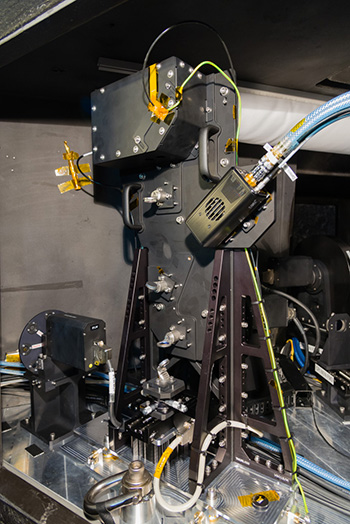
The FIM is installed in the IFS arm of SPHERE, downstream of the extreme adaptive optics (ExAO) system and the coronagraph (see picture on the left). Because space is limited within the SPHERE enclosure, the FIM is designed as a vertical board that contains all the necessary optomechanical elements. The light from the IFS beam is redirected to the FIM using a pick-off mirror installed on a linear translation stage that is inserted into the beam when HiRISE is used. The telescope pupil is reimaged on a mirror glued on a piezo tip-tilt platform, which is used to move the image in the focal plane with an accuracy of the order of 0.01 λ/D. Conceptually, the FB remains static with respect to the FIM, and it is the science image that is moved with respect to the fibers using the tip-tilt mirror. The FIM includes a near-infrared tracking camera that is used to image the focal plane. The tracking camera is used in various calibrations and in the target acquisition procedure that is used to center the PSF of the planet on the science fiber. For optimal photon sharing, the FIM includes a dichroic filter that sends the YJ bands to the tracking camera and the H band to the science fibers. All the optics of the FIM include anti-reflection (AR) coatings to optimize the overall transmission, which amount to ~90% in the H band.
An electronics cabinet is also implemented on the SPHERE side, directly on the Nasmyth platform. This cabinet contains all the necessary electronics for the control of the FIM as well as calibration light sources for the FIM and the FEM. The instrument workstation running Linux and the 2022 release of the VLT Software is also embedded directly in the cabinet as a fan-less industrial computer. The cabinet is connected to the observatory control network using a Cisco switch.
The FB is a single piece of hardware that routes science and calibration fibers from SPHERE to CRIRES. It was manufactured by FiberTech Optica (Canada). It has a total length of 83.9 m, divided into three sections: a short section in SPHERE (2.5 m), a long section around the telescope (78.2 m), and another short section in CRIRES (3.2 m). The FB includes various fibers for the science and the calibrations as illustrated below. The science fibers (yellow and light blue) go all the way from the input to the output ferrules. All the calibration fibers enter or exit the bundle at the junction between the SPHERE section and the long section that goes around UT3.

The science and calibration fibers used for HiRISE in the bundle are single mode fibers (SMF) from Coherent, model 1310M-HP. These fibers offer a very low attenuation in the H band, less than 0.5 dB/km at 1.55 µm that translates into an expected transmission ≥0.989 for a 100 m fiber. On either sides of the bundle, the two custom ferrules are made of Invar to avoid stresses due to temperature variations and they are AR-coated with coatings optimized up to 1.850 μm on both sides. Taking into account the coating and the fiber, the FB transmits ~95% of the light that couples into the science fiber.

The fibers are protected within a PVC-coated stainless interlock monocoil conduit. The FB was routed around the UT3, starting on the SPHERE side, using existing cable ducts. The route follows cable ducts underneath the azimuth platforms and then follows the telescope structure to reach the inner track of the telescope under the azimuth floor.
The FEM within CRIRES is a much simpler system with just a few optics to reimage the output of the science fibers in the VLT focal plane at F/15, which is what is expected by the spectrograph. The FEM is located in the calibration carrier stage of CRIRES (see picture on right), which is at the entrance of the warm bench of the instrument. The warm bench contains the instrument derotator, the MACAO deformable mirror, and the MACAO wavefront sensor (Paufique et al. 2004; Dorn et al. 2023). Again, the system is optimized to maximize the transmission in the H band, with an expected 90% transmission in that band. The optical design includes a folding mirror to make the FEM more compact and to allow feeding the FB from the top, which makes the connection and deconnection much simpler. Since it is installed at the location of a visitor gas cell, the FEM has been designed to be easily removed in the case of an observing run requiring a visitor gas cell or during technical interventions.
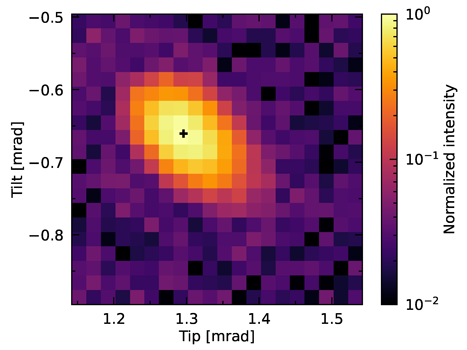
The operations of HiRISE involve three systems: SPHERE, the FIM and CRIRES. They key part of the acquisition is the centering of a planet's PSF on the science fiber. The work of Otten et al. (2021) has demonstrated that the end-to-end transmission of the system is the main driver of the performance, which means that the planet's PSF must be centered at better than 0.2 λ/D. Our investigation work in the laboratory at LAM demonstrated that this accuracy is reachable provided that some calibrations are performed (El Morsy et al. 2022), such as injection maps on the science fiber (see picture on left). During the commissioning in July 2023, we consolidated the approach and established a clear sequence of daily calibrations to be performed with HiRISE to be able to reach the required accuracy on the sky. A key aspect of the target acquisition with the FIM is that the centering is performed on the internal source of SPHERE and then relies on the differential tip-tilt sensor (DTTS) to place the star at the requested location when going to sky. The commissioning results demonstrated the validity of our approach with a measured peak end-to-end transmission of more than 4%, within the range expected from design.
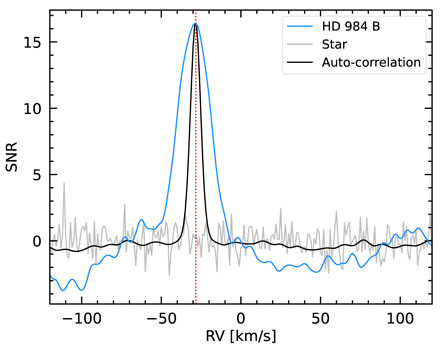
During commissioning we performed a first demonstration of the system's performance on the brown dwarf companion HD984B (Meshkat et al. 2015). The companion was observed during one hour and the cross-correlation function (CCF) analysis on the HiRISE data is showed on the right plot. The signal of the companion is clearly identified at a signal-to-noise ratio of 15 and at the expected radial velocity shift of -28 km/s. From the data we are also able to measure the broadening of the CCF, which indicates that the companion spin is at least 13 km/s.
In November 2023, we started the HiRISE survey target a large sample of known directly-imaged companions to study their composition, measure their orbital velocity and rotation rate, look for exo-moons, etc. The survey relies on accurate astrometry gathered with SPHERE, GPI, GRAVITY to be able to accurately place the HiRISE science fiber at the location of the companions. The conduction and exploitation of the HiRISE survey is done in the framework of project MIRAGES, funded by the French national research agency (ANR) in collaboration with OCA, IPAG, and LESIA.
HiRISE consortium
The HiRISE project has involved many people with various skills and expertise. The following list is mostly focused on the scientific preparation, design, integration and validation of the instrument. Team members directly funded by the HiRISE ERC project are highlighted.
LAM: A. Vigan, M. El Morsy, M. Lopez, G. Otten, J. Garcia, J. Costes, E. Muslimov, A. Viret, Y. Charles, A. Costille, M. Houllé, J.-L. Beuzit, K. Dohlen, R. Pourcelot, M. Jaquet, F. Jaubert, A. Abinanti, P. Balard, J. A. Benedetti, P. Blanchard, E. Choquet, P. Cristofari, T. Ely, N. Garcia, J. Le Merrer, C. Sehim, N. Tchoubaklian, P. Tomlinson
University of Göttingen: A. Reiners, H. Anwand-Heerwart
Durham University: G. Murray
ESO Garcching: G. Zins, J. Paufique, U. Seemann, R. Dorn, M. Kasper, D. Popovic
ESO Chile: A. Smette, J. Valenzuela Soto, L. Blanco, E. Fuenteseca, L. Pallanca, R. Schmutzer
University of Exeter: I. Baraffe, M. Phillips
Other institutes: M. N'Diaye, A. Carlotti, D. Mouillet, S. Rochat, S. Desidera, A.-L. Maire
Press coverage
HiRISE has received some coverage in the press following its installation and commissioning at the VLT:
- CNRS/INSU: press release
- Science et avenir: article
- optics.org: article
- First light imaging: article
- Enviscope: article
- Universe Today: article
- Le Monde: article
- CORDIS (EU research results): article
Publications
- Characterization of AF Lep b at high spectral resolution with VLT/HiRISE
- 2025, A&A, 696, A6
- First light of VLT/HiRISE: High-resolution spectroscopy of young giant exoplanets
- 2024, A&A, 682, A16
- Validation of strategies for coupling exoplanet PSFs into single-mode fibres for high-dispersion coronagraphy
- 2022, A&A, 667, A171
- Connecting SPHERE and CRIRES+ for the characterisation of young exoplanets at high spectral resolution: status update of VLT/HiRISE
- 2022, SPIE, 12185
- Experimental validation of exoplanet centring strategies for high dispersion coronagraphy
- 2022, SPIE, 12185
- Direct imaging and spectroscopy of exoplanets with the ELT/HARMONI high-contrast module
- 2021, A&A, 652, A67
- Calibration of residual aberrations in exoplanet imagers with large numbers of degrees of freedom
- 2021, A&A, 649, A170
- Direct characterization of young giant exoplanets at high spectral resolution by coupling SPHERE and CRIRES+
- 2021, A&A, 646, A150
- Retrieving scattering clouds and disequilibrium chemistry in the atmosphere of HR 8799e
- 2020, A&A, 640, A131
- Bringing high-spectral resolution to VLT/SPHERE with a fiber coupling to VLT/CRIRES+
- 2018, SPIE, 10702